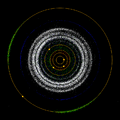Kirkwood gap facts for kids
Kirkwood gaps are special empty spaces found within the asteroid belt. The asteroid belt is a huge ring of rocks and dust orbiting the Sun between Mars and Jupiter. In these "gaps," there are much fewer asteroids than you would normally expect to find.
These gaps happen because of the strong gravity of the giant planet Jupiter. Jupiter's gravity pulls on the asteroids in a special way, creating what scientists call "orbital resonances."
The Kirkwood gaps were first discovered in 1857 by a scientist named Daniel Kirkwood. He was a professor at Jefferson College in Canonsburg, Pennsylvania. Kirkwood was also the first to correctly explain why these gaps exist. He figured out they were caused by the orbital resonances with Jupiter.
Contents
What Are Kirkwood Gaps?
Imagine a busy highway where cars are usually spread out. Kirkwood gaps are like empty stretches on that highway where very few cars are driving. In space, these "empty stretches" are specific orbits within the asteroid belt. Asteroids that would normally be in these orbits are missing.
These gaps are found at certain distances from the Sun. These distances relate to how long it takes an asteroid to orbit the Sun compared to Jupiter's orbit. For example, if an asteroid takes exactly half the time Jupiter takes to orbit the Sun, it might be in a Kirkwood gap.
How Jupiter Creates the Gaps
The main reason for Kirkwood gaps is orbital resonance. This happens when two orbiting objects have orbital periods that are simple fractions of each other. For example, a 2:1 resonance means one object orbits twice for every one orbit of another.
- Jupiter's Strong Pull: Jupiter is the largest planet in our Solar System. Its huge gravitational pull affects everything around it, including the asteroids.
- Repeated Pushes: If an asteroid's orbit is in a resonance with Jupiter, Jupiter will pull on it at the same point in its orbit, over and over again. It's like pushing a swing at just the right time.
- Kicking Asteroids Out: These repeated gravitational pushes build up over time. They can make the asteroid's orbit very unstable. Eventually, the asteroid gets "kicked out" of that particular orbit. It might move to a different orbit, or even be thrown out of the asteroid belt entirely.
- Empty Spaces: Over millions of years, this process clears out asteroids from these specific resonant orbits. This creates the empty spaces we call Kirkwood gaps.
Where Are the Gaps Found?
The most noticeable Kirkwood gaps are found at specific orbital resonances with Jupiter. These include:
- 3:1 resonance: An asteroid orbits the Sun three times for every one orbit of Jupiter.
- 5:2 resonance: An asteroid orbits the Sun five times for every two orbits of Jupiter.
- 7:3 resonance: An asteroid orbits the Sun seven times for every three orbits of Jupiter.
- 2:1 resonance: An asteroid orbits the Sun two times for every one orbit of Jupiter.
These gaps are not completely empty. A few asteroids might still be found there. However, they are much less crowded than other parts of the asteroid belt.
Images for kids
See also
 In Spanish: Huecos de Kirkwood para niños
In Spanish: Huecos de Kirkwood para niños



